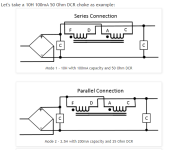Hi everyone, quick question:
What happens when I use a choke above it's current rating?
I have some 200 mA chokes I would like to use in an amp that consumes 250 mA.
(I have two with 150 Ohm dcr, and two with 75 Ohm)
Thanks!
What happens when I use a choke above it's current rating?
I have some 200 mA chokes I would like to use in an amp that consumes 250 mA.
(I have two with 150 Ohm dcr, and two with 75 Ohm)
Thanks!
Depends on the amp.
If it's a class AB push-pull, you may get away with it... until next summer.
Best is to play it safe and use 2 in parallel, resulting in half the inductance and twice the current.
If it's a class AB push-pull, you may get away with it... until next summer.
Best is to play it safe and use 2 in parallel, resulting in half the inductance and twice the current.
It gets closer to core saturation. When saturation occurs, inductance begins to drop. If a choke is used in saturation, it can be considered as a swinging choke.
It also gives off more dissipated power from the Rdc losses
It also gives off more dissipated power from the Rdc losses
Be aware the circuits shown are special cases with a shared core (mutual coupling).
A "normal" case with 2 separate chokes and minimal mutual coupling gives Ls = L1 + L2, and same with Rs.
A "normal" case with 2 separate chokes and minimal mutual coupling gives Ls = L1 + L2, and same with Rs.
Hello,
I am so used to using Lundahl chokes where i would end up with just 25 % of the inductance!!
If you have a '' professionally '' made choke you would have some safety margin. But most brands nowadays wont be happy with 25 % extra current.
In stead of putting two chokes in parallel i would put yours on swap meet and get the right one.
Some time ago there were some Lundahls available here on swap meet in Belgium.
Probably easier to install than two chokes next to ach other.
Greetings, Eduard
I am so used to using Lundahl chokes where i would end up with just 25 % of the inductance!!
If you have a '' professionally '' made choke you would have some safety margin. But most brands nowadays wont be happy with 25 % extra current.
In stead of putting two chokes in parallel i would put yours on swap meet and get the right one.
Some time ago there were some Lundahls available here on swap meet in Belgium.
Probably easier to install than two chokes next to ach other.
Greetings, Eduard
If I may, I'd like to add a qualifier to your statement: ''' professionally '' made by old guys'.
Half a century ago, when I was attending school, "safety margin" was a big thing, ranging from 20% to 50+% on top of nominal.
Nowadays, I'd be happy to derate published specs by 50% and get away with it. 🙂 🙂 🙂
Half a century ago, when I was attending school, "safety margin" was a big thing, ranging from 20% to 50+% on top of nominal.
Nowadays, I'd be happy to derate published specs by 50% and get away with it. 🙂 🙂 🙂
Miniwatt, it depends on a few technical details. You have identified one detail - the operating current is nominally 250mA and steady (due to class A operation). What you haven't identified are the chokes and their specs (apart from DCR). Even if you know the part numbers, and the manufacturer has more specs, it is still likely difficult to determine how much the inductance falls with dc current out to 250mA, and whether that is really a concern for your amp, and further whether the internal winding temperature would exceed what the manufacturer intended to be an upper limit.
You may be lucky and the inductance tapers off in such a way as to not be a concern, but you may want to technically confirm that - ie. not a simple process if you don't have sufficient test equipment and time etc.
You may also be lucky and your room temperature is on the cool side, and the choke operates in an environment where it is not heated by other nearby parts (valves and PT), and sits close to ambient room temp. In that situation a circa 60% increase in internal dissipation may still be acceptable, but it depends a lot on the original manufacturers built in safety margins and max ambient temp spec.
You may be lucky and the inductance tapers off in such a way as to not be a concern, but you may want to technically confirm that - ie. not a simple process if you don't have sufficient test equipment and time etc.
You may also be lucky and your room temperature is on the cool side, and the choke operates in an environment where it is not heated by other nearby parts (valves and PT), and sits close to ambient room temp. In that situation a circa 60% increase in internal dissipation may still be acceptable, but it depends a lot on the original manufacturers built in safety margins and max ambient temp spec.
- Home
- Amplifiers
- Tubes / Valves
- Choke current rating
